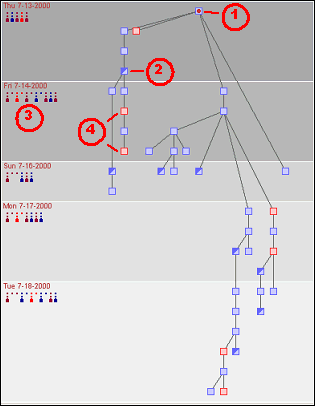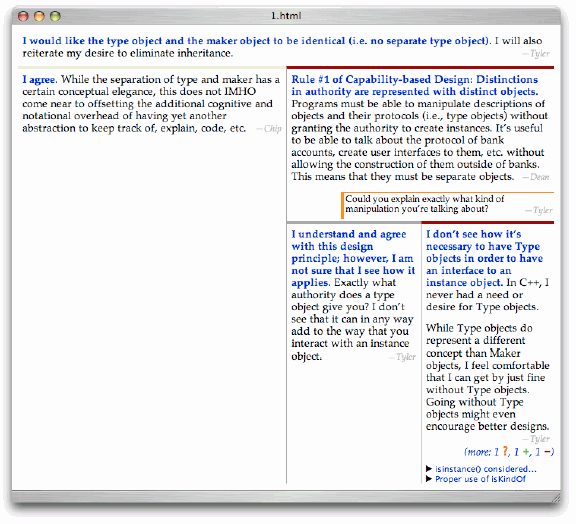Of course, I find it useful because it highlights that the fundamental difference between message boards and blogs is simply one of distributed hosting. The basic structure is still that each post is an object with one of it's properties being connecting data. That connecting data might be of a comment to a parent post or a post on blog B trackbacked to blog A. This, believe it or not, is the same underlying structure of a message board.
That's not to say that switching an object ID in a database for a URL isn't significant. It's insanely significant. Distributed systems are far more interesting that centralized system. But I think that a system that didn't ultimately wind up as a threaded discussion system would be far more interesting.
Some much smarter people than me are already thinking about this. Paul Resnick mentions his Beyond Threaded Conversationworkshop held in conjunction with this week's CHI 2005 Conference. They set up a wiki which includes the original submissions by the workshop participants.
Straight to the point, Marc Smith's Enhanced interfaces for threaded conversations(MSWord file) outlines what data is useful for creating enhanced threaded views and shows an example of a Thread Tree:

Another view of grouping replies comes from Ka-Ping Yee and Marti Hearst in A Visualization to Facilitate Productive Discussions(pdf):

Derek Hansen's Health FACTS: From Conversation to Archive and Back Again(MSWord file) caught my interest because it identifies a problem in my current work. I'll be interested to see how people respond to his peer-pressure model of getting people to clean up their posts for archiving, but I like the idea of a nomination system for identifying and archiving the best discussions. It's something I have done by hand, but it was labor intensive and not scalable. The lyrics to the swan-song of many good ideas.
Yevgeniy Medynskiy mentions ways we can derive Implicit Links in Asynchronous Communication Spaces(pdf). There has already been a number of visualizations of explicit links of social networks. In fact, Conversation Tracker uses explicit trackback links to create a visualization of the blogosphere. However, implicit links can be far more interesting. A comment on a blog mentioning the blogger's birthday implies a relationship beyond the blog. The number of times fark is mentioned on boingboing vs. the times boingboing is mentioned on fark reveals what we already know--that boingboing picks up a lot of content from fark, but not the other way 'round. I see many interesting applications such as revealing who posts more comments than original blog posts (across the blogosphere) or determining the strength of ties between folks. Who are the main posters and trackbackers? Who are the people engaged in dialog? How do these groups interact and bridge?
Even within the confines of threaded discussions, there is a lot of room for innovation. If you have additional examples beyond threaded conversations, please comment and share them.


